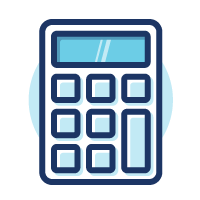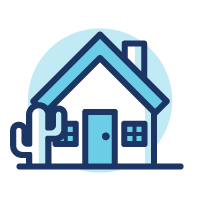Adjustable-Rate Mortgage (ARM) Pros and Cons
An adjustable-rate mortgage can offer a lower monthly home payment when interest rates are high.

Key Takeaways
- An advantage of an adjustable-rate mortgage is that they start with lower rates and provide flexibility.
- A disadvantage of an adjustable-rate mortgage is that your payment will potentially increase after the introductory period.
- An adjustable-rate mortgage loan might be a good idea for you if you plan to sell or refinance before the variable rate period begins.
Arizona homebuyers are starting to hear more about the benefits of purchasing a home with an adjustable-rate mortgage – or an “ARM loan.” That’s because ARM loans offer some serious benefits during these times of higher interest rates.
But what is the advantage of an adjustable-rate mortgage and is an ARM loan a good idea for you? Here we’ll cover what ARM mortgages are, how they work, their pros and cons, and some frequently asked questions to help you determine if an ARM loan is the right choice for your situation.
What is an ARM Mortgage?
Adjustable-rate mortgages are home loans with interest rates that after the fixed term can go up or down over time depending on the interest rate market. Contrast that to more traditional fixed-rate mortgages that maintain the same interest rate over the life of the loan.
At first glance, this may not sound as appealing as a fixed-rate mortgage which gives you the peace of mind knowing your payment remains the same each month. However, there are certain scenarios when adjustable-rate mortgages may be the perfect choice when purchasing a home with a mortgage.
How Do ARM Loans Work?
Unlike a fixed-rate mortgage where the interest rate on the mortgage remains the same for the life of the loan, an adjustable-rate mortgage does exactly what it sounds like — it adjusts.
The appealing part of a mortgage with an adjustable rate is the lower introductory rate.
The starting rate is set at a fixed rate for a period that can last anywhere from three to ten years. Once the introductory period is over, the rate moves to a variable (or adjustable) rate for the remainder of the loan.
How much the rate changes is dependent on the Interest Rate Market conditions and ARM Caps.
ARM caps are the maximum amount the interest rate can go up and are broken down in three different ways:
- The first rate adjustment could hit the cap in the first adjustment year.
- Subsequent adjustments, in which increases or decreases are limited by the interest rate caps, occur periodically throughout the loan.
- The lifetime rate cap is the maximum amount the interest rate can increase during the entire loan term.
When looking at the ARM caps, one of the questions you should ask your mortgage lender is exactly when the rate can adjust and how much your payment might be with all three rate caps. Then you can determine if you'll be able to afford the monthly mortgage payment if you were to reach the ARM's caps during the life of the mortgage.
Adjustable-Rate Mortgage Pros and Cons
Pros of an Adjustable-Rate Mortgage
- Ease into homeownership with lower payments during the introductory phase. One of the primary attractions of ARM loans is the lower initial interest rate compared to fixed-rate mortgages. This can translate to lower monthly payments during the initial fixed-rate period, making homeownership more affordable, especially for first-time buyers or those with tight budgets.
Pro tip: OneAZ offers ARM loan options where your rate is locked-in for the first 5, 7 or 10 years of your loan.
- You have flexibility if you consider this home purchase being a more temporary move. If you anticipate selling the property or refinancing before the initial fixed-rate period ends, an ARM loan can offer flexibility with lower initial payments without committing to a long-term fixed interest rate.
- You’re protected by Interest Rate Caps. Most ARM loans come with built-in protections in the form of interest rate caps which limit how much your mortgage interest rate and monthly payments can increase during each adjustment period over the life of the loan. This provides a measure of predictability and security if you happen to still own the property during the adjustment phase.
- Your payments could potentially decrease. While the interest rate on an ARM loan can increase, there's also a possibility that it may decrease, particularly if market interest rates trend downwards. This means you could benefit from lower monthly payments in the future without having to refinance.
Cons of an Adjustable-Rate Mortgage
- Your monthly payments might increase: The main disadvantage of an ARM loan is the uncertainty associated with future interest rate adjustments. If market rates rise, your monthly payments could increase within the caps described previously, something you will need to be prepared for.
- Variable payments come with uncertainty: Unlike fixed-rate mortgages, where you know exactly what your monthly payments will be for the entire loan term, ARM loans introduce variability and uncertainty, making it challenging to budget for future housing expenses. Note: Monthly payments can still increase with fixed rate-mortgages due to increased Taxes and Insurance.
- Adjustable-rate mortgages are more complex than fixed-rate mortgages: ARM loans can be more complicated to understand due to their variable nature and the various terms and conditions involved, including adjustment caps, index rates, margins, and adjustment periods, requiring borrowers to be diligent in researching and fully comprehending the terms of the loan.
How Often Will My Rate Adjust?
Understanding when and how often your interest adjusts is a key part of knowing whether an ARM loan is right for you.
Most ARM loans are hybrid loans that are broken into two phases: the fixed-rate period and the variable-rate period.
You’ll see these loans expressed as 3/1, 5/1, 7/1 and 10/1 OR 3/6, 5/6, 7/6 and 10/6
- The first number is how long the introductory fixed rate will last in years. In both cases above, it’s 3, 5, 7, or 10 years.
- The second number refers to how often the rate can change after that. In the cases of the 3/1, 5/1, 7/1 and 10/1 loans, this is once every year or annually. For 3/6, 5/6, 7/6 and 10/6 loan the interest rate would adjust every 6 months. Typically, loans that adjust once annually have 2% periodic caps, while loans that adjust semiannually have 1% periodic caps.
Is an ARM Loan a Good Idea for You?
Whether an ARM loan is a good fit for you depends on your financial situation, risk tolerance, and long-term housing plans.
If you recognize that you aren’t likely to remain in the property indefinitely and value the initial lower interest rate and payments, an ARM loan could be a good fit.
However, if you prefer the stability and predictability of fixed-rate payments or plan to stay in the home for an extended period, a fixed-rate mortgage might be a better choice.
ARM Loan Frequently Asked Questions
What happens when an adjustable-rate mortgage adjusts?
Many borrowers worry about what happens if things don’t go as planned. If you’re uncertain if you will move before the fixed period ends, consider the longer 7- or 10-Year Fixed Term ARMs. If your plans change, and it appears you will remain in the property longer than anticipated, consider refinancing during the fixed period before the adjusting phase begins.
What is an advantage of an adjustable-rate mortgage?
An advantage of an ARM loan is the potential for lower initial payments during the fixed-rate period compared to fixed-rate mortgages. This has the potential to save you thousands of dollars in interest.
What is a disadvantage of an adjustable-rate mortgage?
A disadvantage of an ARM loan is the uncertainty associated with future interest rate adjustments, which could lead to higher monthly payments.
Can you refinance an ARM loan?
Yes, assuming you qualify, you can refinance an ARM loan to either secure a fixed-rate mortgage or to adjust the terms of your existing ARM loan.
How soon can you refinance an ARM loan?
The timing for refinancing an ARM loan depends on a few factors, including any prepayment penalties, current market conditions, and your financial goals. OneAZ does not have a prepayment penalty on any residential first mortgage loans.
Is an adjustable-rate mortgage the same as a variable-rate mortgage?
Yes, the terms are interchangeable.
How are the interest rates calculated with an ARM?
The lender you choose will determine which of the various indexes they will use to set your rate. A "margin" will then be added to the rate which is a fixed percentage added to the index rate to calculate the new rate.
How much can my interest rate adjust?
When obtaining an adjustable-rate mortgage, it's important to understand the ARM Caps. This will tell you the maximum amount your rate can go up after the introductory period ends, the maximum it can increase each year throughout the loan, and the maximum it can increase through the life of the loan.
When Arizona homebuyers are exploring their mortgage options, it may be a great idea to go with an adjustable-rate mortgage. However, make sure you have a plan in place for when the rate does adjust and always play it safe by anticipating on the rate adjusting higher.
When working with your lender and determining your future payments using the ARM caps, decide if you could afford the monthly mortgage payment if the rates increase to the maximum amount.
OneAZ Adjustable-Rate Mortgages
Unlock affordability in today’s market.
Chris “Peach” Petrie is the founder of Money Peach. Money Peach partnered with OneAZ to provide free financial education to members across the state. To learn more about OneAZ’s partnership with Money Peach, click here.
APR = Annual Percentage Rate

















